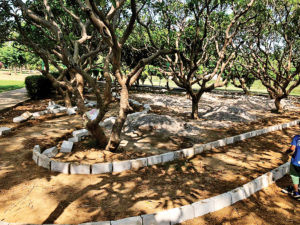Concretisation in parks and installation of open gyms is sparking alarm about the depleting ground water level in the Capital
It’s 7 in the morning and people of all age-groups are vigorously working out on machines in the open gym at a DDA park in East Delhi. The machines are working fine, apart from the squeaks they emanate when used. The atmosphere is lively and energetic, as everyone is trying to break a sweat.
When open gyms for the general public were first introduced by the Kejriwal government — for free — the idea seemed a thoughtful step in the direction of public health. Even though the gyms are working well, there is an issue: they are indirectly having adverse effects on the environment, which was probably overlooked while devising this idea.
In this case, the DDA (Delhi Development Authority) is under fire. In order to protest the concretisation of these open gyms in public parks which come under DDA, a petition by the name of Children’s Right to Play was filed in the Delhi High Court last year by Rajiv Suri, an environmental activist.

“There are 18,000 parks in Delhi right now. In these, children perhaps don’t even have 2% of the area to themselves. Public authorities will put up two swings and they call it a play area. What about the kids in the age group 8-14? They need active sports. So they play on the streets,” says Suri.
“We need open area and land for moisture to percolate down. If water doesn’t reach the underground aquifer, where will it be stored?” questions Suri. He states that a zero-tolerance policy needs to be adopted by the public towards the concretising of parks.
As part of the Delhi Trees SOS campaign, Suri along with other people opposed the cutting of trees in Sarojini Nagar, which is going through redevelopment currently. The campaign that is being run by him — Rivers and Water SOS — is to address the issue of water problem in the city.
What do open gyms have to do with the water problems in the city? Shortage of ground water, since concrete does not allow seepage. The concretisation of parks in the form of jogging paths, boundaries around trees and concrete flooring all block water runoffs.
In case of Nehru Park, many trees are surrounded by concrete boundaries, having adverse effects on tree growth. These trees are currently being suffocated as a result of urbanisation.
A cluster of trees in the park can be seen crisscrossed by concrete paths. While these paths don’t have concrete flooring, the boundaries are almost hugging the trees, making it a case of negligence on the part of DDA.
Not only does this violate the National Green Tribunal (NGT) order dated April 23, 2013, but it also points to the fact that the public authority is neglecting the issue of groundwater – something about which NITI Aayog has already warned the Capital.
The Composite Water Management Index (2018) states that the city will be left with no groundwater by 2020. With added negligence of DDA in not noticing the effects of concretising the parks, and especially the open gyms, has exacerbated the issue.
To further address the problem Suri, along with activist Verhaen Khanna, and other members met the Vice Chairman of DDA to show how concretising of parks is detrimental to the environment.
The VC not only took note of their concern, but also gave support to removing the concrete flooring from all the DDA parks, according to the message Patriot received from Khanna. The latest example of the concretising of an open gym was seen in Sanjay Van. As soon as the situation was reported, the flooring was removed. But this is yet to be done for all the open gyms in the city.
These activists also learnt that there will be a layer of synthetic rubber over the concrete layer, in order to protect people from getting hurt in case they fall from machines. This material is as bad as concrete.
While this is a problem specific to DDA parks in the city, the open gyms in parks run by NDMC (New Delhi Municipal Corporation) and SDMC (South Delhi Municipal Corporation) have mud floors with no layer of cement or rubber flooring.
Time and again there’s been an outcry by environmentalists over concretisation of open spaces like public parks. They say that this unhealthy development will harm cities with extremely low ground water levels.
The concrete surface not only prevents seepage of the water into the soil but also creates imbalances in the temperature cycle. The concrete surface radiates heat waves in the evening, and given the current temperature figures in Delhi, the surface makes nights as hot as days, while the maximum and minimum temperature cycle fluctuates.
“People need to make a choice when it comes to looking at these things. The concrete substance is polluting the environment and also adding to the problem of ground water depletion,” says pilot turned environmentalist Verhaen Khanna.
Khanna says concretisation of parks not only it violates the NGT order but it is also killing the biological ecosystem in the parks. “Concrete flooring kills the earthworms and other living species in these parks. Putting these small living beings at danger is against the environment,” says Khanna.
Several reports on the depletion of ground water says that there’s an urgent need for soil, vegetation and structural interventions — some of which can be started through local efforts. People must understand that while parks serve a great purpose for the betterment of people’s health, they also simultaneously put it in danger.
It’s a known fact that walking or standing for a prolonged period leads to tension in muscles and joints. So, wouldn’t it be wise to clear the concrete paths and flooring from these parks, which would also add space for groundwater seepage?





